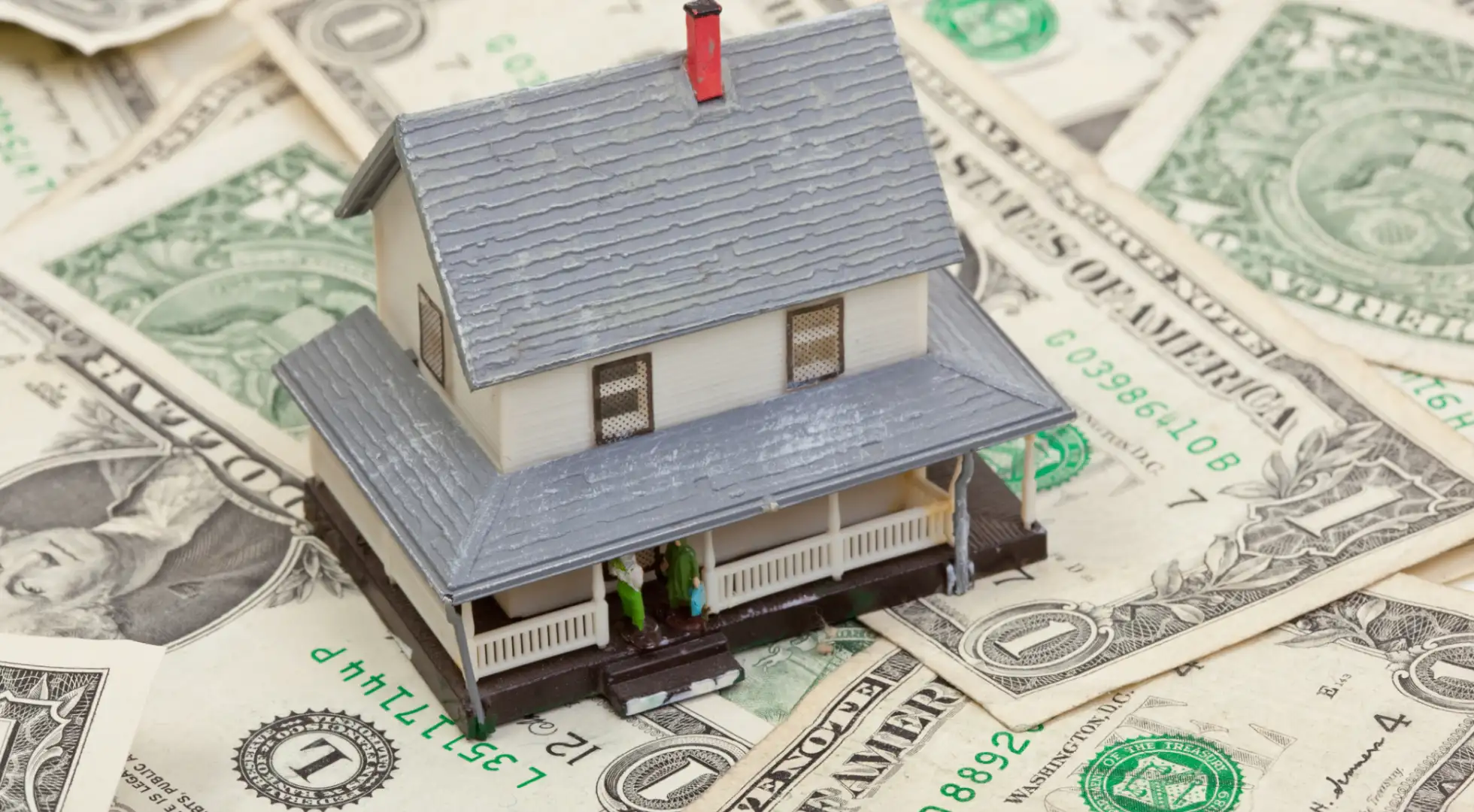7 Steps: Cash-Out Refinance To Buy an Investment Property

Buying an investment property is a great plan for wealth creation and semi-passive income for your future.
So, can you get a cash-out refinance on your primary home and use the funds for a down payment on an investment/rental property?
Yes, you can. Here’s how to do that and some insights on whether it’s a good idea.
Table Of Contents
Step 1: Make Sure You Have Enough Equity
Step 2: Figure Out How Much the Cash Will Cost You
Step 3: Determine Rental Property Cash Flow & ROI
Step 4: Decide if a Home Equity Line or Loan Is Better Than Cash-Out
Step 5: Get the Cash-Out Refinance on Your Primary Home
Step 6: Apply for the Investment Property Loan
Step 7: Buy the Investment Property, Find a Tenant
Cash-Out Refinance to Purchase a Rental Property: FAQ
Get Started on Your Cash-Out Refinance or HELOC To Buy an Investment Property
Step 1: Make Sure You Have Enough Equity
Make sure you have enough equity in your home. To get the best rates, you’ll want:
- Maximum 75% loan-to-value (LTV) on your primary home after the cash is taken out
- Maximum 75% LTV (25% down) on the new rental property
Here’s an example.
| Primary home value | $500,000 |
| New cash-out loan | $375,000 |
| Current loan balance | -$250,000 |
| Closing costs | -$7,000 |
| Cash out | $118,000 |
| Max rental property price (Cash received divided by 0.25) | $472,000 |
In this example, you would have 25% equity left in your home and be able to put down 25% on the new property.
You can go up to 80% loan-to-value on the cash-out loan and the rental property loan, according to Fannie Mae rules. But rates start to skyrocket.
Step 2: Figure Out How Much the Cash Will Cost You
Rates are likely higher than when you received your primary residence mortgage. Your payment can rise dramatically if you go from 4% to 7% while increasing your loan balance.
Make sure the cash is worth it. Here’s an example, assuming you need $75,000 cash for the new rental property plus $7,000 in closing costs.
| Loan amount | Interest rate | Monthly payment | |
| Current loan | $250,000 | 4% | $1,194 |
| Cash-out loan | $332,000 | 7%* | $2,209 |
| Additional monthly cost | $1,015 |
Step 3: Determine Rental Property Cash Flow & ROI
Ensure the property will produce enough cash to justify the extra expense on your primary home.
This isn’t as straightforward as it seems. I recommend Bigger Pockets rental property calculator to determine how much profit the property will produce. The calculator factors in things like loan payment, vacancy, and repairs.
It’s tempting to calculate a monthly profit using rent income minus the payment. But as someone who owns two rental properties, I can say this isn’t your true profit.
Here’s a simplified example of rental property cash flow assuming a $300,000 rental property purchase.
| Rental property price | $300,000 |
| Down payment (25%) | $75,000 |
| Final loan | $225,000 |
| P&I payment at 7.5%* | $1,573 |
| Tax, insurance | $300 |
| Vacancy, repairs, management | $500 |
| Total rental property monthly cost | $2,373 |
| Rental income | $2,500 |
| Profit | +$127 |
Even with high gross rental income, the property still only cash flows $127 per month, not enough to justify incurring a primary home payment of more that increased more than $1,000.
But run your own numbers. Maybe your scenario makes more sense than my example. This might be the case if:
- Your primary home interest rate stays about the same or drops with the refi
- You’re planning to flip the property, not rent it out
- The rental property purchase price point is a lot lower
- You’re getting the property below market
- You’re buying a short-term rental where monthly rental income is much higher
Come to your own conclusion, but hopefully, this example shows the factors you should consider.
Step 4: Decide if a Home Equity Line or Loan Is Better Than Cash-Out
If your primary residence's rate is currently very low, say 3-4%, consider a home equity line of credit (HELOC) or home equity loan.
You don’t have to take a higher rate on your primary mortgage to get a large amount of funds.
And home equity lines and loans come with much lower closing costs than cash-out refi.
A HELOC is likely better if you only need $25,000-$75,000, depending on your current first mortgage balance and rate.
| Cash-out refinance | Existing loan + HELOC | Existing loan + home equity loan | |
| 1st mortgage | $332,000 @ 7%* | $250,000 @ 4% | $250,000 @ 4% |
| 1st mortgage payment | $2,209 | $1,194 | $1,194 |
| $75k 2nd mortgage (8%)* | N/A | $500 (interest-only) | $627 (fully-amortizing 20-year loan) |
| Total P&I payment | $2,209 | $1,694 | $1,821 |
In this case, it’s probably better to leave your first mortgage alone and get a HELOC or home equity loan. Unless rates drop significantly from current levels (6.5-7.5% in early 2024), a 2nd mortgage will likely pencil out better.
Step 5: Get the Cash-Out Refinance on Your Primary Home
If you’ve determined that taking cash out to buy an investment property makes sense, the next step is to get the cash-out refinance on your home.
Getting a cash-out refinance is similar to a regular refinance. The major difference is that you are taking a bigger loan than you owe. At closing, escrow wires you the overage after paying off your existing loan and covering closing costs.
Here’s the basic process
- Shop around for a lender to ensure you’re getting the best rate and fee structure
- Apply for the loan
- Submit your paystubs, W2s, tax returns, bank statements, and other items the lender might ask for
- Once approved, the lender will send final loan documents to escrow
- Sign final paperwork
- The loan closes, and escrow wires you cash-out funds
About a Cash-Out Letter of Explanation
The lender may ask for a letter of explanation for the cash-out funds.
Fannie Mae states that you can use cash-out funds for any purpose. However, the lender has the right to ask what the funds are for.
Don’t volunteer the information if not asked. The lender may want to know the future loan terms and rental income terms. Then you have a real chicken-and-egg problem since you don't know the terms yet. Just say you'll use the funds for various investment opportunities.
Step 6: Apply for the Investment Property Loan
Next, you’ll get a preapproval to make an offer on an investment property.
It’s a good idea to get full preapproval by submitting all your documentation. If you apply with the same lender, your loan officer may be able to use some of the same paperwork you submitted for the cash-out loan.
Applying to buy a rental property is similar to buying a primary home, with a few differences:
Reserves
You may have to prove reserves if you have other financed investment properties. Reserves are extra funds in the bank after closing. Here’s what Fannie Mae requires.
- 2% of unpaid balances if 1-4 properties owned
- 4% of unpaid balances if 5-6 properties owned
- 6% of unpaid balances if 7-10 properties owned
Your primary home and the rental home you’re buying don’t count toward financed properties owned.
Using Future Rental Income To Qualify
Fannie Mae allows you to use future rental income to qualify. The appraiser reports market rent on Fannie Mae form 1007 or current lease agreements if the property is already rented. The lender will request the 1007 along with the appraisal.
Step 7: Buy the Investment Property, Find a Tenant
The final step is to use your preapproval to find an investment property.
Make an offer and complete the loan process. You are now a landlord.
Find a great tenant or market the home as a short-term rental.
With great management, the property will yield income for years.
Cash-Out Refinance to Purchase a Rental Property: FAQ
Are cash-out funds for an investment property tax deductible?
No. IRS rules state that only the portion of the mortgage balance used to purchase or improve your primary home is tax deductible.
Should I take out a HELOC to buy an investment property?
This could be a better idea than replacing a low-rate primary mortgage. A HELOC does not affect your first mortgage, so you keep your low rate. However, a HELOC comes with a variable rate, potentially meaning higher payments in the future. Consider a home equity loan, which comes with a fixed rate.
What are the current rates on a cash-out refinance?
All mortgage rates are currently relatively high compared to the last ten years. That’s why it’s important to determine whether the cash is worth the higher rate you’ll be taking on. A cash-out refinance requires you to replace your first mortgage, at which point you lose your current low rate.
Get Started on Your Cash-Out Refinance or HELOC To Buy an Investment Property
Buying an investment property is one of the best ways to secure future semi-passive income and equity appreciation.
If a cash-out refi pencils out, it’s a great way to raise funds for the down payment on a rental.




